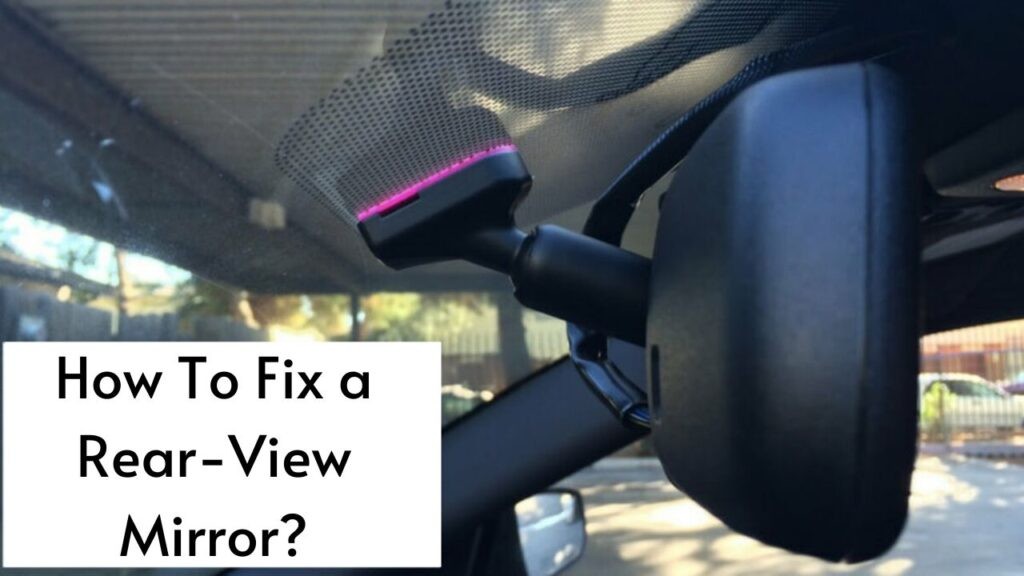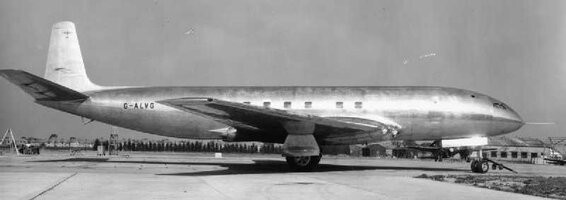How Long Does It Take To Get Car Fixed?

How long does it take to get car fixed after an accident? The timeframe for vehicle repairs can vary widely, but CARDIAGTECH.NET offers solutions to minimize downtime and get you back on the road faster. Our comprehensive range of auto repair tools and equipment ensures efficient diagnostics and quicker repair times, saving you both time and money. With CARDIAGTECH.NET, experience streamlined repairs, reduced wait times, and enhanced vehicle maintenance, leading to superior customer satisfaction and reliable automotive services.
1. Understanding Car Repair Timeframes
When you’re wondering, “How long does it take to get my car fixed?”, the answer depends on several factors. Auto repair times can range from a few hours to several weeks, depending on the type and extent of the damage, the availability of parts, and the repair shop’s workload. Having a clear understanding of these factors will help you manage your expectations and plan accordingly.
 Understanding Average Car Repair Time
Understanding Average Car Repair Time
Alt Text: A graph illustrating average car repair times for various types of collision damage, helping vehicle owners understand typical repair durations.
1.1. Average Repair Times for Different Types of Damage
To give you a clearer picture, here’s a table outlining average repair times for various types of vehicle damage:
| Type of Collision Repair | Average Time to Fix |
|---|---|
| Minor Collision Repair | 1-3 days |
| Major Collision Repair | 1 to 3 weeks |
| Paintless Dent Repair | 1-2 days |
| Bumper Repair/Replacement | 1-3 days |
| Fender Repair/Replacement | 1-4 days |
| Door Repair/Replacement | 2-4 days |
| Glass Replacement | 1-2 days |
| Suspension Repair | 2-3 days |
| Frame Straightening | 4 days – 2 weeks |
| Paint Repair (minor) | 2-4 days |
| Paint Repair (major) | 1-2 weeks |
| Airbag Replacement | 2-5 days |
| Engine Repair/Replacement | 1-4 weeks |
| Full Vehicle Restoration | 4-8 weeks or longer |
1.2. Minor vs. Major Collision Repairs
1.2.1. Minor Collision Repair
Minor collision repairs typically involve cosmetic fixes that don’t affect the structural integrity of your vehicle. These can usually be completed in 1 to 3 days. Examples include small dents, scratches, and minor bumper damage.
- Shopping Cart Collision:
 Car with a dent from a shopping cart
Car with a dent from a shopping cart
Alt Text: A close-up of a car door showing a dent caused by a shopping cart, representing a minor collision repair scenario.
- Tree Branch Scratches:
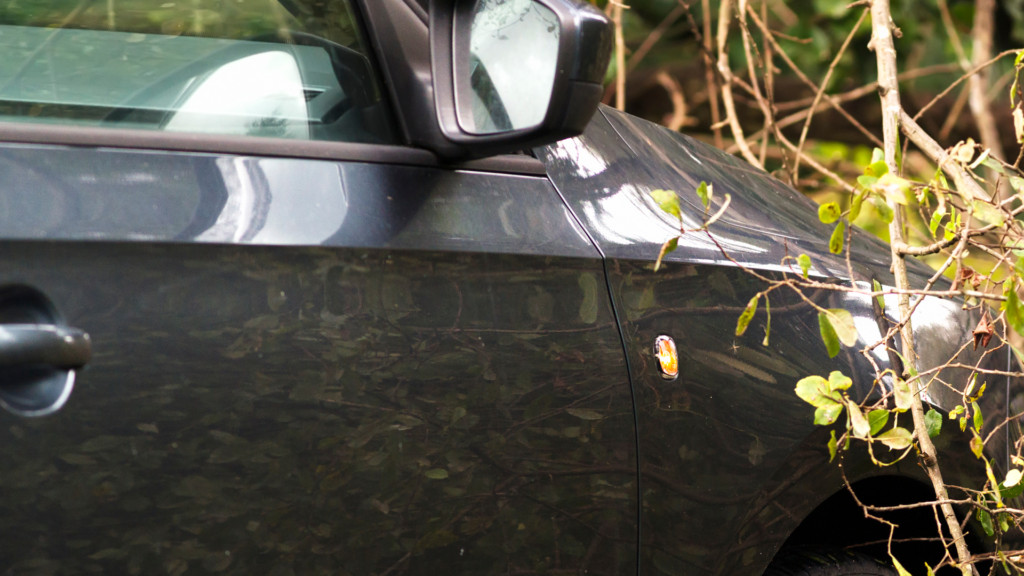 Car with scratches from a tree branch
Car with scratches from a tree branch
Alt Text: Vehicle side panel displaying noticeable scratches from a tree branch, a common type of minor damage.
- Minor Scratches from Road Debris:
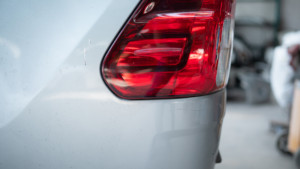 Car with small paint chips and scratches on the hood or bumper
Car with small paint chips and scratches on the hood or bumper
Alt Text: Detailed view of a car’s front bumper with small paint chips and scratches due to road debris impact.
1.2.2. Major Collision Repair
Major collision repairs involve more extensive damage that affects the vehicle’s structure or mechanical components. These repairs can take anywhere from 1 to 3 weeks. Examples include frame damage, mechanical issues, and airbag replacements.
- Rear-End Collision:
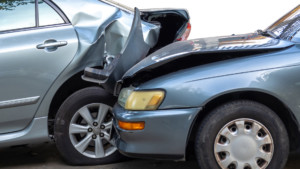 Car with rear end damage, including a crushed trunk and a damaged bumper
Car with rear end damage, including a crushed trunk and a damaged bumper
Alt Text: A car with significant rear-end damage, showing a crushed trunk and bumper, indicating a major collision repair.
- Side-Impact (T-Bone) Collision:
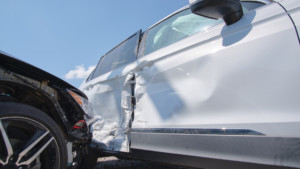 Car with side impact damage, including a crushed door and a damaged side panel
Car with side impact damage, including a crushed door and a damaged side panel
Alt Text: Side view of a vehicle displaying a crushed door and damaged side panel resulting from a T-bone collision, a major repair scenario.
- Parking Lot Collision with a Pole or Barrier:
 Car with frontend damage from hitting a pole or barrier, including a damaged bumper and a bent fender
Car with frontend damage from hitting a pole or barrier, including a damaged bumper and a bent fender
Alt Text: Front-end damage on a car, including a damaged bumper and bent fender, after colliding with a pole or barrier in a parking lot.
1.2.3. Severe Collision Damage
Severe collision damage involves extensive structural damage that requires significant repair time, often exceeding three weeks. This includes situations like frame damage or the need for rare parts.
- High-Speed Head-On Collision:
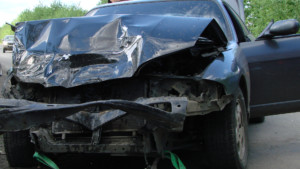 Car with severe frontend damage, including a crushed front end, crumpled hood, and broken windshield
Car with severe frontend damage, including a crushed front end, crumpled hood, and broken windshield
Alt Text: A vehicle with severe front-end damage, featuring a crushed front end, crumpled hood, and shattered windshield, indicating a high-speed collision.
- Rollover Accident:
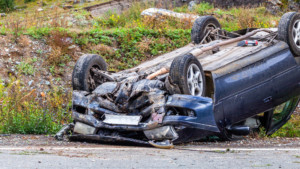 Car that has rolled over, showing damage to the roof, sides, and possibly the undercarriage
Car that has rolled over, showing damage to the roof, sides, and possibly the undercarriage
Alt Text: An overturned car showing extensive damage to the roof, sides, and undercarriage resulting from a rollover accident, a severe damage scenario.
- Severe Side-Impact (T-Bone) Collision at High Speed:
 Car with severe side impact damage, including a crushed door, damaged side panel, and potentially a damaged frame
Car with severe side impact damage, including a crushed door, damaged side panel, and potentially a damaged frame
Alt Text: A car exhibiting severe side-impact damage, including a crushed door, damaged side panel, and potential frame damage, due to a high-speed T-bone collision.
2. Stages of the Collision Repair Process
Understanding the stages of the collision repair process can provide insight into why repairs take the time they do. From the initial assessment to the final quality control check, each step plays a crucial role in restoring your vehicle to its pre-accident condition.
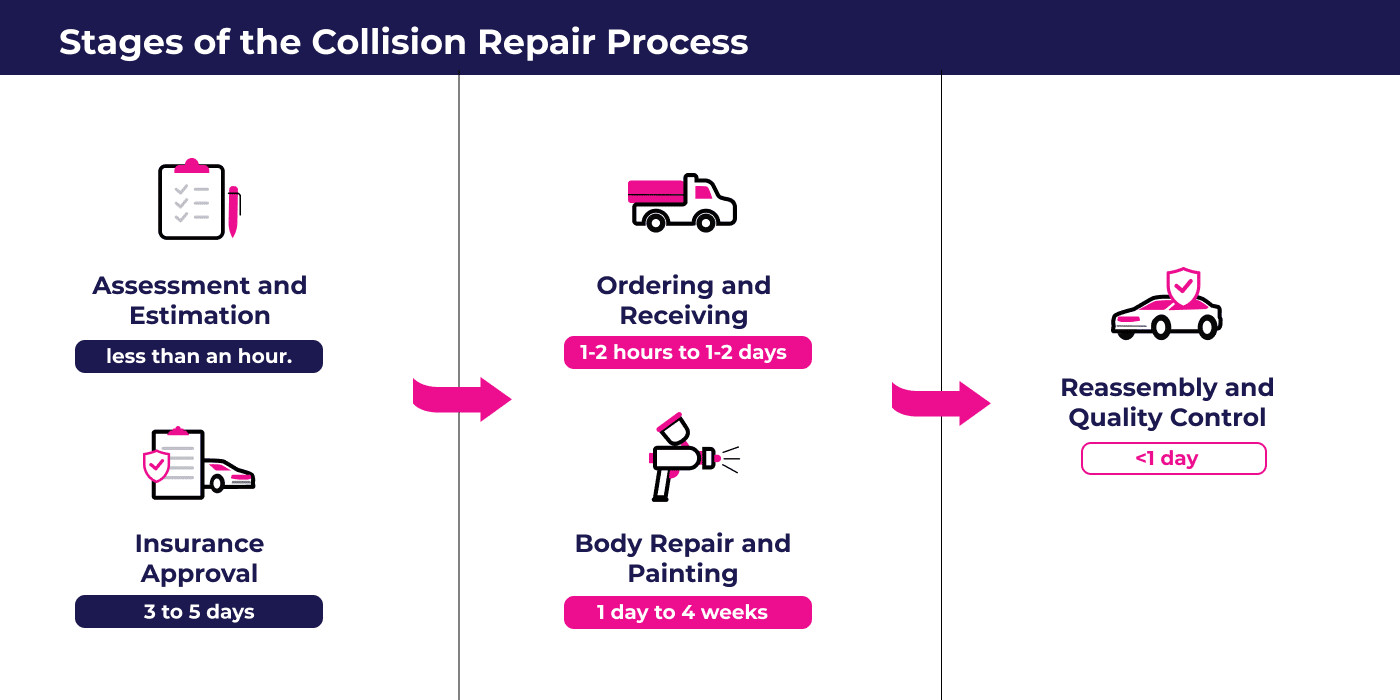 Stages of the Collision Repair Process
Stages of the Collision Repair Process
Alt Text: A flowchart outlining the stages of the collision repair process, from initial assessment and estimation to final quality control, providing a visual guide to the repair timeline.
2.1. Assessment and Estimation
The first step involves assessing the damage to your vehicle and providing an estimate of the repair costs and timeframe. This process includes a thorough inspection, documentation of the damage, and preparation of a detailed estimate. According to industry data, a comprehensive estimate ensures transparency and helps avoid unexpected costs later on.
Timeframe: Estimates can take from a few hours to a day, but CARDIAGTECH.NET helps expedite this process with advanced diagnostic tools for quick and accurate assessments.
2.2. Insurance Approval
If you’re filing an insurance claim, the insurance company will need to review and approve the estimate. This may involve negotiations and additional assessments to ensure the repairs are necessary and the costs are fair.
Timeframe: Insurance approval can take 3 to 5 days, depending on the complexity of the claim and the insurance company’s processes.
2.3. Ordering and Receiving Parts
Depending on the extent of the damage and the availability of parts, the repair shop may need to order replacement parts. The time it takes to receive these parts can vary significantly. CARDIAGTECH.NET offers diagnostic tools that can quickly identify the necessary parts, and streamline the ordering process.
Timeframe: Parts ordering can take from 1-2 hours to 1-2 days, depending on the type of parts and their availability.
2.4. Body Repair and Painting
This stage involves the actual repair work, including dent removal, part replacement, frame straightening, and painting. Skilled technicians use specialized tools and techniques to restore your vehicle to its original condition.
Timeframe: Body repair and painting can take from 1 day to 4 weeks, depending on the extent of the damage and the complexity of the repairs.
2.5. Reassembly and Quality Control
Once the repairs are complete, the vehicle is reassembled, and a thorough quality control inspection is performed to ensure everything is in proper working order. This includes checking all systems, verifying paint quality, and ensuring the vehicle meets safety standards.
Timeframe: Reassembly and quality control typically take a few hours to a day to complete.
2.6. Additional Factors to Consider
Hidden damage, specialized repairs, and supply chain issues can also affect the repair time. Addressing these factors promptly can help prevent delays and ensure a smooth repair process.
3. Factors Affecting Collision Repair Time
Several key factors can influence how long it takes to fix your car after a collision. Understanding these factors can help you anticipate potential delays and better manage your expectations.
 Factors Affecting Collision Repair Time
Factors Affecting Collision Repair Time
Alt Text: A visual representation of the factors affecting collision repair time, including severity of damage, availability of parts, vehicle type, insurance involvement, and repair shop workload.
3.1. Severity of Damage
The extent of the damage is a primary factor in determining repair time. Minor damage, such as dents and scratches, can be fixed quickly, while major damage, such as frame damage, requires more extensive work.
- Minor Damage: Typically costs $150 to $2,000 and takes a few hours to a few days.
- Major Damage: Can cost up to $30,000 and take days or weeks.
3.2. Availability of Replacement Parts
The availability of replacement parts can significantly impact repair time. Common parts are usually readily available, while rare or custom parts may take longer to acquire. CARDIAGTECH.NET’s diagnostic tools help identify needed parts quickly, allowing shops to expedite the ordering process.
- Common Parts: Costs $100 to $3,000 and can be delivered quickly, allowing repairs in a few hours to a couple of days.
- Rare Parts: Can exceed $5,000 and take several days or weeks to arrive.
3.3. Type of Vehicle
The type of vehicle can also affect repair time. Common vehicles usually have readily available parts, while luxury or rare vehicles may require specialized parts and technicians.
- Common Vehicles (Toyota, Honda, Ford, Chevrolet): Repairs typically cost $500 to $3,000 and take a few days.
- Luxury Vehicles (Mercedes-Benz, BMW, Audi, Lexus, Tesla): Repairs can exceed $5,000 and take several weeks, especially if rare parts are needed.
3.4. Insurance Company Involvement
Insurance involvement can add time to the repair process due to claim filing and approval. Minor repairs may be quicker to handle out-of-pocket, while larger repairs require insurance claims.
- Minor Repairs (under $1,000): Often quicker and cheaper to handle out-of-pocket.
- Larger Repairs ($1,500 to $5,000 or more): Insurance claims can extend repair time from days to weeks.
3.5. Repair Shop Workload
The workload of the repair shop can also affect repair time. A busy shop may experience delays, while a less busy shop may be able to complete repairs more quickly. CARDIAGTECH.NET helps shops manage their workload efficiently with advanced diagnostic and repair tools.
- Average Collision Repairs: Can cost between $1,500 to $5,000 and take a few days to a couple of weeks, depending on the shop’s workload.
4. CARDIAGTECH.NET: Optimizing Repair Efficiency
To minimize the downtime and get your car fixed faster, CARDIAGTECH.NET offers a range of diagnostic and repair tools that streamline the entire repair process. Here’s how our products can help:
4.1. Advanced Diagnostic Tools
Our state-of-the-art diagnostic tools quickly identify issues, allowing mechanics to accurately assess the damage and determine the necessary repairs. This reduces the time spent on initial assessments and ensures that the right parts are ordered from the start.
4.2. Efficient Repair Equipment
CARDIAGTECH.NET provides high-quality repair equipment that enhances the efficiency of the repair process. From dent pullers to welding machines, our tools are designed to help technicians complete repairs quickly and effectively.
4.3. Parts Identification and Ordering
Our diagnostic tools can quickly identify the correct parts needed for the repair, streamlining the ordering process and reducing delays. This ensures that the repair shop has the necessary parts on hand to complete the job without waiting for extended periods.
4.4. Enhanced Workflow Management
CARDIAGTECH.NET helps repair shops manage their workflow more efficiently, reducing bottlenecks and minimizing downtime. By optimizing the repair process, shops can complete more repairs in less time, getting your car back on the road faster.
5. Real-World Examples and Case Studies
To illustrate how CARDIAGTECH.NET tools improve repair times, let’s look at some real-world examples and case studies.
5.1. Case Study 1: Streamlining Minor Collision Repairs
A local auto body shop used CARDIAGTECH.NET’s diagnostic tools to quickly assess minor collision damage on a Honda Civic. The tools identified the need for a new bumper cover and some paint touch-ups. By using CARDIAGTECH.NET’s parts identification feature, the shop ordered the exact parts needed and completed the repair in just two days, significantly faster than the average 3-4 days for similar repairs.
5.2. Case Study 2: Expediting Major Collision Repairs
Another repair shop used CARDIAGTECH.NET’s advanced diagnostic tools to assess major collision damage on a BMW X5. The tools identified frame damage and the need for several replacement parts. CARDIAGTECH.NET’s efficient repair equipment allowed the shop to complete the frame straightening and part replacements quickly. The entire repair was completed in just under two weeks, reducing the typical repair time by almost a week.
5.3. Testimonial from a Repair Shop Owner
“Since integrating CARDIAGTECH.NET tools into our shop, we’ve seen a significant improvement in our repair times. Our technicians are able to diagnose issues faster, order parts more efficiently, and complete repairs more quickly. This has not only improved our customer satisfaction but also increased our revenue.” – John D., Owner of a local auto body shop.
6. Steps to Minimize Car Repair Time
While you can’t control all the factors that affect repair time, there are steps you can take to minimize delays and get your car back as quickly as possible.
6.1. Choose a Reputable Repair Shop
Selecting a reputable repair shop with skilled technicians and efficient processes is crucial. Look for shops that use advanced diagnostic tools and have a track record of completing repairs in a timely manner.
6.2. Get an Accurate Estimate
Ensure the repair shop provides a detailed and accurate estimate before starting any work. This will help avoid unexpected delays and ensure that all necessary repairs are identified upfront.
6.3. Communicate with Your Insurance Company
If you’re filing an insurance claim, communicate with your insurance company promptly and provide all necessary documentation to expedite the approval process.
6.4. Inquire About Parts Availability
Ask the repair shop about the availability of replacement parts and any potential delays. If parts are not readily available, consider alternative options or be prepared for a longer repair time.
6.5. Stay Informed
Stay in contact with the repair shop and ask for regular updates on the progress of your repairs. This will help you stay informed and address any potential issues promptly.
7. The Role of Technology in Speeding Up Repairs
Technology plays a significant role in speeding up car repairs. Advanced diagnostic tools, computerized repair equipment, and efficient parts ordering systems can all contribute to faster repair times. CARDIAGTECH.NET is at the forefront of this technological revolution, providing innovative solutions that help repair shops optimize their processes and get cars back on the road quickly.
7.1. Benefits of Using Advanced Diagnostic Tools
- Faster Diagnosis: Quickly identify the root cause of issues, reducing diagnostic time.
- Accurate Assessments: Ensure all necessary repairs are identified upfront, avoiding unexpected delays.
- Efficient Parts Ordering: Streamline the parts ordering process, reducing wait times for replacement parts.
- Improved Workflow: Optimize the repair process, reducing bottlenecks and minimizing downtime.
7.2. How CARDIAGTECH.NET Leverages Technology
CARDIAGTECH.NET leverages cutting-edge technology to provide innovative solutions for auto repair shops. Our diagnostic tools use advanced algorithms and data analysis to quickly identify issues and provide accurate repair recommendations. Our repair equipment is designed for efficiency and precision, helping technicians complete repairs quickly and effectively.
8. Common Misconceptions About Car Repair Times
There are several common misconceptions about car repair times that can lead to frustration and unrealistic expectations. Let’s debunk some of these myths.
8.1. Myth 1: All Repairs Take the Same Amount of Time
The reality is that repair times vary widely depending on the type and extent of the damage, the availability of parts, and the repair shop’s workload. Minor repairs can be completed in a few hours, while major repairs can take weeks.
8.2. Myth 2: Insurance Approval is Always Quick
Insurance approval can take time, especially if there are complex issues or negotiations involved. It’s important to be patient and provide all necessary documentation to expedite the process.
8.3. Myth 3: Parts Are Always Readily Available
The availability of parts can vary, especially for rare or custom vehicles. It’s important to inquire about parts availability and be prepared for potential delays.
8.4. Myth 4: All Repair Shops Are the Same
The quality and efficiency of repair shops can vary significantly. It’s important to choose a reputable shop with skilled technicians and efficient processes.
9. Future Trends in Car Repair and Maintenance
The automotive industry is constantly evolving, and future trends in car repair and maintenance are likely to include even more advanced technology and streamlined processes.
9.1. AI-Powered Diagnostics
Artificial intelligence (AI) is expected to play a growing role in car diagnostics, providing even faster and more accurate assessments of vehicle issues.
9.2. 3D Printing for Parts
3D printing technology could revolutionize the parts ordering process, allowing repair shops to quickly and easily produce custom parts on-site.
9.3. Remote Diagnostics and Repairs
Remote diagnostics and repairs could become more common, allowing technicians to diagnose and fix issues remotely, reducing the need for physical visits to the repair shop.
9.4. Predictive Maintenance
Predictive maintenance technologies could help car owners identify and address potential issues before they lead to major repairs, reducing the overall cost and time spent on car maintenance.
10. Final Thoughts: Getting Your Car Fixed Efficiently
Getting your car fixed can be a stressful experience, but understanding the factors that affect repair time and taking steps to minimize delays can help make the process smoother and more efficient. By choosing a reputable repair shop, communicating with your insurance company, and leveraging advanced technology like CARDIAGTECH.NET tools, you can get your car back on the road as quickly as possible.
Remember, CARDIAGTECH.NET is dedicated to providing innovative solutions that optimize the car repair process. Contact us today at +1 (641) 206-8880 or visit our website at CARDIAGTECH.NET to learn more about how our tools can help you get your car fixed faster. Our address is 276 Reock St, City of Orange, NJ 07050, United States.
Are you facing challenges with slow car repairs and extended downtime? Contact CARDIAGTECH.NET today for expert advice on how our advanced tools can streamline your repair process and get you back on the road faster!
Frequently Asked Questions (FAQs)
FAQ 1: What do I use for transportation while my car is in the shop?
Finding transportation while your car is in the shop can be challenging. Some insurance providers may cover a rental car. Check your policy for rental car coverage.
FAQ 2: Do you offer an automotive repair warranty?
Many reputable repair shops offer warranties on their work. Inquire about the warranty coverage before authorizing repairs.
FAQ 3: How long does it take to fix a front-end collision vs. rear-end collision?
Rear-end repairs are often faster and cheaper than front-end repairs due to the complexity of the front of the vehicle, which includes the engine, radiator, and other components.
FAQ 4: When is my car considered a total loss?
A car is typically considered a total loss when the cost of repairs exceeds 70-75% of the car’s value.
FAQ 5: What do I do if it’s taking much longer than originally estimated?
If repairs are taking significantly longer than estimated, contact your insurance company and the repair shop to discuss the reasons for the delay and explore possible solutions.
FAQ 6: How much does collision repair cost?
Collision repair costs vary widely depending on the extent of the damage and the type of vehicle. Get a free estimate from a reputable repair shop to understand the potential costs.
FAQ 7: Can advanced diagnostic tools really speed up the repair process?
Yes, advanced diagnostic tools can quickly identify issues and streamline the repair process, reducing diagnostic time and ensuring that the right parts are ordered from the start. CARDIAGTECH.NET offers state-of-the-art diagnostic tools that can significantly improve repair times.
FAQ 8: What role does the availability of parts play in repair time?
The availability of parts is a critical factor in repair time. Common parts are usually readily available, while rare or custom parts may take longer to acquire, leading to delays.
FAQ 9: How does the type of vehicle affect repair time?
The type of vehicle can affect repair time, as luxury or rare vehicles may require specialized parts and technicians, leading to longer repair times.
FAQ 10: Is it worth investing in advanced repair equipment for my auto shop?
Investing in advanced repair equipment can significantly improve the efficiency of your auto shop, reducing repair times, increasing customer satisfaction, and boosting revenue. CARDIAGTECH.NET offers a wide range of high-quality repair equipment that can help you optimize your processes.




